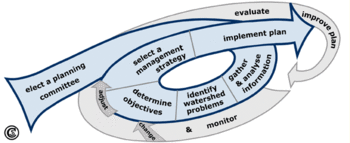Overview of the planning cycle
The planning process in Watershed Management consists of a combination of different planning modes (planning models) [9] :
- The planning process encompasses seven steps (see figure) (rational planning).
- The involvement of the public and all stakeholders is essential in every planning stage (transactive planning). Together they plan and work for an environmentally and socio-economically healthy watershed that benefits all.
- The sequence of steps is not to be strictly adhered to; in fact, it is important to be flexible (adaptive planning). Some steps can be taken simultaneously, while others have to be repeated due to changed conditions or information. Monitoring is carried out during the whole process (although monitoring is together with evaluation explained here as the last step).
The outcome of the planning process is an elaborated Watershed Management Plan which is essentially a rural development concept which is to be implemented. This will serve to guide activities which are carried out to achieve the determined objectives [10]. The systematic but flexible framework for watershed planning is introduced in this chapter. The first preparatory step is to elect a planning committee.



